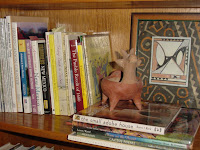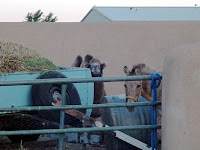Checking out some road kill one morning while out on my dawn bike ride, I saw what looked like a
very large (formerly alive) snake. It didn’t have rattles, but I wasn’t sure what kind it was. After doing some research, I determined that it was a bull snake. Here is what I learned.
There are 46 species of snakes in New Mexico, but only 8 of them are poisonous. These include 7 species of rattlesnakes and a type of coral snake. The bull snake, so named because some think it makes a bull-like snort when threatened, is a non-venomous snake that relies on mimicry to defend itself. It might coil up and make a hissing sound while shaking its tail. Of course, this is likely to remind its enemy of a rattlesnake. It can even somewhat flatten its head to resemble that of a rattler, although (unlike the rattlesnake) the bull snake’s head and neck are actually of the same width. If this behavior doesn’t frighten off the perceived enemy, the bull snake might lunge toward it. Personally, I would have been long gone, but readers of this blog already know that it doesn’t take much to send me packing (see
The Big, Big Spider and the Brave Red Shoes post).
The bull snake (Pituophis melanoleucus sayi) is a subspecies of pine-gopher snake (Pituophis catenifer). It is found in the U.S. west, the south, and the southeast in deserts, forests, coastal dunes, and grasslands or agricultural areas. It is often associated with prairie dog towns. We have a lot of prairie dogs right around where we live, although their habitat is rapidly being dug up and turned into housing lots, so it's not surprising to find bull snakes close by.
It is one of the largest snake species in the U.S., ranging from three to eight feet, but usually averaging around five feet in length. It is brown, yellow-brown, or cream colored, with black and brown markings.
It feeds on mice, rabbits, ground squirrels, prairie dogs, lizards, ground-nesting birds and their eggs, and even other snakes. Because it helps control rodents, it is really the farmer’s friend, and some farmers will allow a bull snake to live under a porch or in a barn. It constricts, or squeezes, its prey and then eats it whole, usually head first. In turn, it is preyed upon by coyotes, kit foxes, red-tailed hawks, and eagles.
Bull snakes are diurnal, which means that they are active during the day, although they may also be about at night during hot weather. They hunt in the early morning, late afternoon, and early evening. They hibernate in the winter, denning* with other bull snakes and sometimes with rattlers, racers, and even garter snakes.
They mate from March through April, and the clutch of 5 to 19 leathery eggs is laid in loose soil during July or August. Hatchlings emerge in early autumn, and must find their own way in the world, as there is no parental involvement.
In captivity, bull snakes have been known to live up to 22 years. However, because they are comparatively slow moving, in the wild they are often killed when crossing roads or basking on roadways. This road danger, together with ongoing habitat destruction, considerably shortens their average life expectancy.
*******************************************
*The idea of snakes denning in a great mass is an intriguing one to me and has been so ever since I read the children’s book,
A Gathering of Garter Snakes, by Bianca Lavies. I highly recommend this book, which is about the famous Narcisse Snake Dens in Manitoba (
http://www.gov.mb.ca/conservation/wildlife/managing/snakes.html). You can borrow Lavies’ book at your library, of course!
*******************************************
For more information about bull snakes, visit these web sites.
Desert U.S.A.:
http://www.desertusa.com/mag99/july/papr/gophersnake.htmlEnchanted Learning--For a drawing of the bull snake constricting and suffocating (and eating) its prey:
http://www.enchantedlearning.com/subjects/reptiles/snakes/Bullsnake.shtmlNatural Source; An educator’s guide to South Dakota’s natural resources.
http://www.northern.edu/natsource/REPTILES/Bullsn1.htmTexas Parks and Wildlife:
http://www.tpwd.state.tx.us/huntwild/wild/species/bullsnake/For a very interesting and somewhat disturbing (well,
I found the part about trapping snakes using a glue board and then freeing them using vegetable oil disturbing, but you might not) article on snakes in New Mexico, read
New Mexico Snakes — recognizing the poisonous ones and controlling them around homes, by James E. Knight, at
http://www.southernnewmexico.com/Articles/Wildlife/NewMexicosnakes-recognizi.html Thanks go to my New Hampshire herpetologist friends, Tanya and Andy, for technical advice for this post.
 I don't think that you can go to Pecos National Historical Park without feeling a connection to the past. I've never been anywhere else where there is such a sense of disturbing history. The Indians there were forced to convert by the Franciscan fathers; their land was colonized, they were forbidden their kivas, and they were made to build an adobe church south of their pueblo. During the Pueblo Revolt of 1680, they rose up, killed the priest, and "built a forbidden kiva in the very convento of the mission."*
I don't think that you can go to Pecos National Historical Park without feeling a connection to the past. I've never been anywhere else where there is such a sense of disturbing history. The Indians there were forced to convert by the Franciscan fathers; their land was colonized, they were forbidden their kivas, and they were made to build an adobe church south of their pueblo. During the Pueblo Revolt of 1680, they rose up, killed the priest, and "built a forbidden kiva in the very convento of the mission."*  When you visit today and look from that kiva to the ruined church, you can easily imagine the Pecos taking back the adobe bricks from the church they were forced to build and using them to reconstruct their sacred kiva.
When you visit today and look from that kiva to the ruined church, you can easily imagine the Pecos taking back the adobe bricks from the church they were forced to build and using them to reconstruct their sacred kiva. Each time we have visited Pecos it has been hot and still, with only the sound of birds and the occasional quiet words of another visitor carrying down the trail on the wind. We step lightly, respecting the rattlesnakes' right to privacy. We look over our shoulders often, for there is always a strong feeling that the current peacefulness of the place is only lightly superimposed on the violence of the past.
Each time we have visited Pecos it has been hot and still, with only the sound of birds and the occasional quiet words of another visitor carrying down the trail on the wind. We step lightly, respecting the rattlesnakes' right to privacy. We look over our shoulders often, for there is always a strong feeling that the current peacefulness of the place is only lightly superimposed on the violence of the past. 


















 Here in eastern New Mexico, on the other hand, I'm not really sure what the coming winter will be like. I do know that we will not be in for those six months of winter we endured every year in New Hampshire. I haven't noticed that our neighbors are doing much preparation, other than putting out some porch decorations of fake fall leaves. Personally, the only change I've made so far is to occasionally wear a long-sleeved shirt with my shorts on my early morning bike rides.
Here in eastern New Mexico, on the other hand, I'm not really sure what the coming winter will be like. I do know that we will not be in for those six months of winter we endured every year in New Hampshire. I haven't noticed that our neighbors are doing much preparation, other than putting out some porch decorations of fake fall leaves. Personally, the only change I've made so far is to occasionally wear a long-sleeved shirt with my shorts on my early morning bike rides. 














